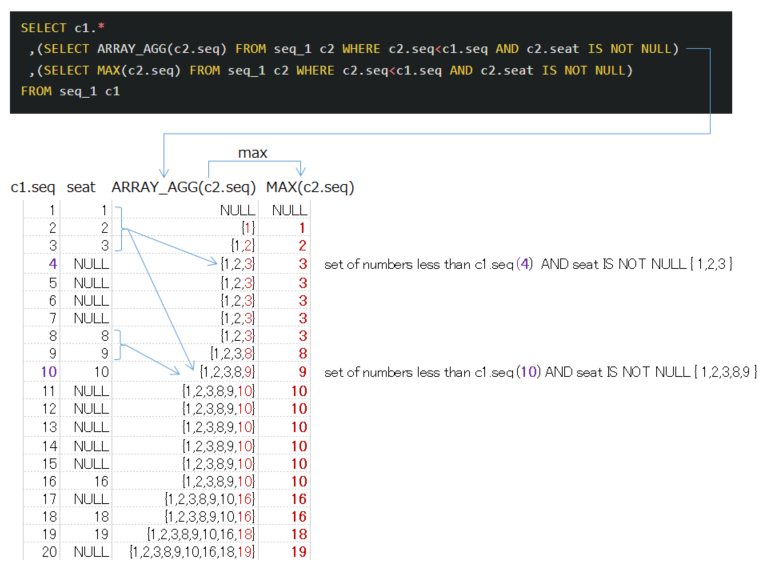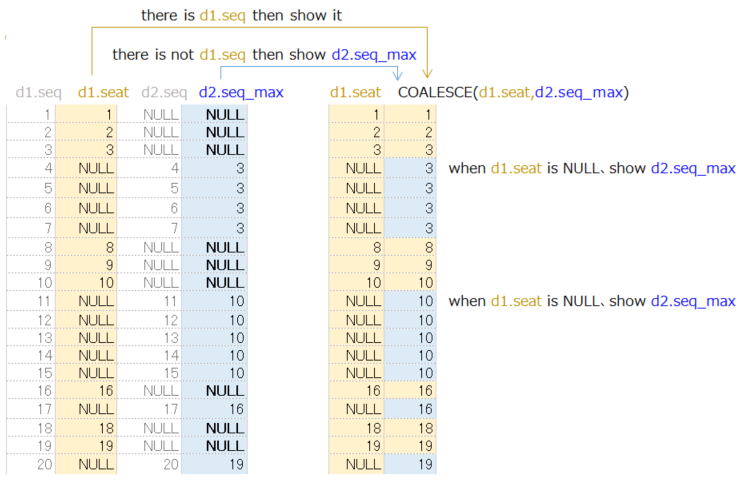Beginning
This article is based on 『SQL Puzzle and Answers』
⇒ #9 Available Seats
It is better with this book to read this article.
In the previous article,
finding empty seats(missing numbers) from numbers
This time
rewrite previous SQL like ・・
fill empty number with the most recent seated number
⇒ output image is below
【step】
① find empty seats
② find recent seated number from Restaurant table
③ fill empty number with these numbers
I wish this could help you to learn SQL techniques
check working with PostgreSQL
Restaurant Table & Data
CREATE TABLE Restaurant(
seat integer -- occupied seat number
);
INSERT INTO Restaurant VALUES(1);
INSERT INTO Restaurant VALUES(2);
INSERT INTO Restaurant VALUES(3);
INSERT INTO Restaurant VALUES(8);
INSERT INTO Restaurant VALUES(9);
INSERT INTO Restaurant VALUES(10);
INSERT INTO Restaurant VALUES(16);
INSERT INTO Restaurant VALUES(18);
INSERT INTO Restaurant VALUES(19);
Create conecutive numbers(1~20)
-- conecutive numbers(1~20)
WITH RECURSIVE seq_0 AS (
SELECT 1 AS seq
UNION ALL
SELECT seq + 1 FROM seq_0 WHERE seq < 20
)
SELECT * FROM seq_0
-- Output
-- 1
-- 2
-- ・
-- ・
-- 20
Create conecutive numbers
using Recursive Query
⇒ check below article
Creating base table
WITH RECURSIVE seq_0 AS (
SELECT 1 AS seq
UNION ALL
SELECT seq + 1 FROM seq_0 WHERE seq < 20
)
SELECT b1.seq, b2.seat
FROM seq_0 b1
LEFT JOIN Restaurant b2 ON b1.seq = b2.seat
ORDER BY b1.seq
Join the Restaurant table to consecutive numbers
⇒ this is base table
⇒ we are going to join data to this table
Edit Joined data①
WITH RECURSIVE seq_0 AS (
SELECT 1 AS seq
UNION ALL
SELECT seq + 1 FROM seq_0 WHERE seq < 20
)
,seq_1 AS (
SELECT b1.seq, b2.seat
FROM seq_0 b1
LEFT JOIN Restaurant b2 ON b1.seq = b2.seat
ORDER BY b1.seq
)
SELECT c1.*
,(SELECT ARRAY_AGG(c2.seq) FROM seq_1 c2 WHERE c2.seq<c1.seq AND c2.seat IS NOT NULL)
,(SELECT MAX(c2.seq) FROM seq_1 c2 WHERE c2.seq<c1.seq AND c2.seat IS NOT NULL)
FROM seq_1 c1
ORDER BY c1.seq
Add ARRAY_AGG() and MAX() in SELECT clause
The work here is preparing to fill with number
if current row is empty(NULL)
ARRAY_AGG(c2.seq)
⇒ Get all seq numbers
that are smaller than c1.seq from seq_1
⇒ a set of numbers
⇒ This is for checking to get the max number
MAX(c2.seq)
⇒ Pick the MAX number from the set
⇒ red letters are the numbers to fill empty
Edit Joined dat②
WITH RECURSIVE seq_0 AS (
SELECT 1 AS seq
UNION ALL
SELECT seq + 1 FROM seq_0 WHERE seq < 20
)
,seq_1 AS (
SELECT b1.seq, b2.seat
FROM seq_0 b1
LEFT JOIN Restaurant b2 ON b1.seq = b2.seat
ORDER BY b1.seq
)
SELECT c1.*
,(SELECT ARRAY_AGG(c2.seq) FROM seq_1 c2 WHERE c2.seq<c1.seq AND c2.seat IS NOT NULL)
,(SELECT MAX(c2.seq) FROM seq_1 c2 WHERE c2.seq<c1.seq AND c2.seat IS NOT NULL)
FROM seq_1 c1
WHERE c1.seat IS NULL -- Add
ORDER BY c1.seq
Add c1.set IS NULL to the WHERE clause
to choose only empty setas(numbers)
Now we have data with numbers in empty seats
use these numnber next
▼ Output(right side of image)
Edit Joined data③
WITH RECURSIVE seq_0 AS (
SELECT 1 AS seq
UNION ALL
SELECT seq + 1 FROM seq_0 WHERE seq < 20
)
,seq_1 AS (
SELECT b1.seq, b2.seat
FROM seq_0 b1
LEFT JOIN Restaurant b2 ON b1.seq = b2.seat
ORDER BY b1.seq
)
,seq_2 AS (
SELECT c1.*
-- ,(SELECT ARRAY_AGG(c2.seq) FROM seq_1 c2 WHERE c2.seq<c1.seq AND c2.seat IS NOT NULL)
,(SELECT MAX(c2.seq) FROM seq_1 c2 WHERE c2.seq<c1.seq AND c2.seat IS NOT NULL) seq_max
FROM seq_1 c1
WHERE c1.seat IS NULL
)
SELECT d1.seq,d1.seat,d2.seq,d2.seq_max
FROM seq_1 d1
LEFT JOIN seq_2 d2 ON d2.seq = d1.seq
Data we created in Creating base table
⇒ left side of above image(yellow)
conscutive number(1~20) & seated number
⇒ seq_1
Data we created in Edit Joined data⓶
⇒ middle of above image(white)
⇒ empty seats(number) have the most recent number
⇒ seq_2
LEFT JOIN seq_1 and seq_2
SELECT d1.seq,d1.seat,d2.seq,d2.seq_max
FROM seq_1 d1
LEFT JOIN seq_2 d2 ON d2.seq = d1.seq
LEFT JOIN is the important part
⇒ right side of above image
⇒ yellow part, these rows has seated number
⇒ blue part, these rows are empty
but there are numbers now(red letter)
⇒ used LEFT JOIN to get these rows
Almost done !
the last job is to fix SELECT statement
Final SQL
WITH RECURSIVE seq_0 AS (
SELECT 1 AS seq
UNION ALL
SELECT seq + 1 FROM seq_0 WHERE seq < 20
)
,seq_1 AS (
SELECT b1.seq, b2.seat
FROM seq_0 b1
LEFT JOIN Restaurant b2 ON b1.seq = b2.seat
ORDER BY b1.seq
)
,seq_2 AS (
SELECT c1.*
-- ,(SELECT ARRAY_AGG(c2.seq) FROM seq_1 c2 WHERE c2.seq<c1.seq AND c2.seat IS NOT NULL)
,(SELECT MAX(c2.seq) FROM seq_1 c2 WHERE c2.seq<c1.seq AND c2.seat IS NOT NULL) seq_max
FROM seq_1 c1
WHERE c1.seat IS NULL
)
SELECT d1.seat,COALESCE(d1.seat,d2.seq_max) seq2 -- Edit
FROM seq_1 d1
LEFT JOIN seq_2 d2 ON d2.seq = d1.seq
Edit SELECT clause
⇒ d1.seat,COALESCE(d1.seat,d2.seq_max) seq2
⇒ when d1.seatt is NULL, show d2.seq_max
COALESCE() is often used
If the column you want to display is NULL,
display a different column
it's often used to avoid display empty





